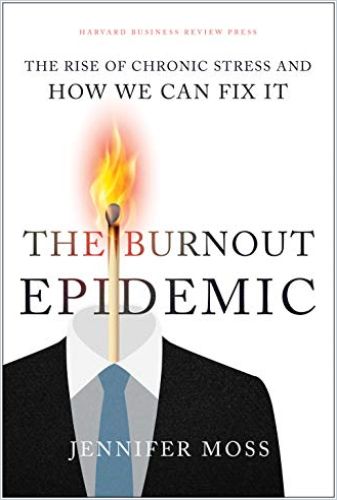Burnout doesn’t stem from personal failing; instead, it signals a workplace in need of change. To combat burnout, leaders must show empathy, and work to build a culture of fairness, accountability and humaneness.

Canaries in the Coal Mine
Researchers who study burnout – and the legions of workers suffering from it – have come to realize that, although individuals can do much to manage their exhaustion and improve their emotional well-being, a lasting solution to fighting burnout will depend on shifts in the workplace culture. With her perceptive book on the subject, Jennifer Moss joins the growing chorus of voices urging meaningful change for the sake of both workers’ wellness and organizational performance.
Moss, a public speaker, radio columnist and award-winning journalist, has covered topics including wellness and emotions in the workplace. As a regular contributor to Harvard Business Review, she has written about grief, loneliness, burnout and stress at work since 2015. Her award-winning book, Unlocking Happiness at Work, makes a business case for the pursuit of happiness in the workplace.
How Burnout Begins
Moss calls burnout “a complex constellation of poor workplace practices and policies, antiquated institutional legacies, roles and personalities at higher risk, and systemic, societal issues that have been left unchanged, plaguing us for far too long.”
The book opens with a thorough exploration of burnout’s root causes and risk factors. Six factors, Moss argues, represent the chief contributors to workers’ feelings of dissatisfaction and stress: unrealistic workloads, a sense of lacking control, inadequate recognition and rewards, poor workplace relationships, unfair workplace practices and misaligned values. She offers specific strategies for leaders to recognize and minimize these burnout triggers in their own organizations.
Burnout can’t be stretched out of people in yoga class or sweated out of them at the gym.Jennifer Moss
Moss also identifies personality traits – such as perfectionism and introversion – that place certain workers at a higher risk of burnout, and professions – like health care, education and the tech industry – where burnout is especially prevalent. She outlines the ways in which workplaces fail to meet these workers’ needs, painting heartrending portraits of the hardships surgeons, teachers and tech employees often endure.
The Leader’s Responsibility
In Moss’s view, although workers can manage their circumstances and symptoms to some extent, the responsibility for fighting burnout lies with leaders – those who hold the power to alter the organizational norms and expectations underlying employees’ stress and dissatisfaction. She points out that leaders often fail to prevent burnout by not paying attention to what their employees truly need. Instead, they show up for them in perhaps well-intentioned but ineffective ways.
For example, employers might think they’re doing employees a favor and demonstrating trust by granting unlimited vacation days, but research shows American workers don’t actually take advantage of this policy. In fact, workers with unlimited plans take fewer vacation days annually than those on traditional plans. Throughout the book, Moss offers concrete, research-based interventions leaders can apply – instead of wellness panaceas – to counter the root causes of burnout, and to bolster positive feelings in themselves and among their people.
The Antidote: Empathy
Moss believes that a single leadership quality holds the key to remedying burnout: empathy. Far from making leaders weak or soft, the author argues, empathy underpins character and ethics; to be empathic often requires strength and toughness. To nurture workers’ well-being, develop trust and build an empathic culture you must practice active listening and encourage constructive dialogue.
Empathic leaders, Moss writes, also reward integrity rather than compliance, creating an environment where workers can act on their values and boosting organizational accountability. As a leader, prioritize workers’ safety – both physical and psychological – and nurture people’s emotional flexibility, including their openness to change and their ability to tolerate negative experiences. Allow people to grieve when they need to do so.
Nurturing Curiosity
Moss draws on burgeoning research to advocate for curiosity as a crucial quality among leaders and workers alike – one that can serve as a valuable weapon in the fight against burnout. As a leadership quality, curiosity enables active listening and facilitates empathy. Leaders who possess curiosity pay attention to the clues people express in everyday conversations, revealing how they feel and what they need.
By creating a culture of curiosity, we embrace empathy, restore calm, enhance creativity and cultivate an innovative mind-set.Jennifer Moss
As a worker, curiosity can reduce negative feelings such as depression, anxiety and stress and help you respond to challenges with fortitude and creativity. Citing research from Google’s Project Aristotle – an initiative to analyze the company’s top-performing teams – Moss recommends keeping team sizes small. When people work in larger groups, communication becomes more difficult and feedback suffers – both are factors that can contribute to burnout. Working in small groups facilitates curiosity and innovation.
Self-Care for Leaders
Leaders suffer burnout, too. To prevent burnout, Moss urges leaders to prioritize self-care – but her prescription goes deep. She advises focusing on finding meaning in your work: Find ways to link your daily tasks to the broader impact your organization makes on the world around you. Bolster your resilience and happiness through practices of gratitude and mindfulness.
To prevent leadership burnout, it’s essential to find the meaning in our work. That feeling can ebb and flow…But if it feels permanently lost, our well-being can suffer.Jennifer Moss
Moss cites research showing that the simple act of writing down positive things that happened during your week can help you sleep better, offset feelings of loneliness, increase compassion, enrich relationships and even strengthen your immune system. A mindfulness practice can help reduce stress by staying present and calming your body’s fight-or-flight response.
A Call for More-Humane Workplaces
Moss reframes the burnout crisis as an opportunity to make work better, to challenge leaders to develop their empathy and to boost business performance by creating a more accountable and mission-led organization. Her practical strategies will inspire you to take steps to improve your own psychological fitness and support others in doing the same, and to show compassion for yourself and the people around you. In The Burnout Epidemic, Moss provides numerous helpful tips companies can apply to encourage empathy, curiosity and healthier norms within the workplace. Leaders who take on board Moss’s valuable advice can overcome burnout and build a healthier, happier, more sustainable – and better-performing – organization.




